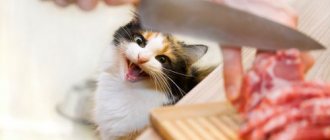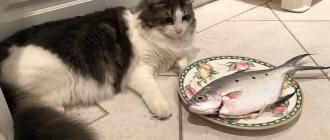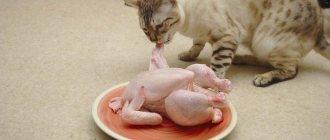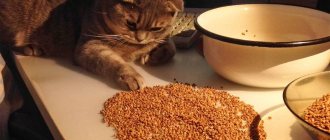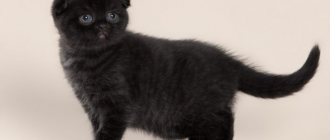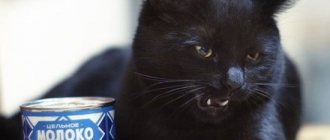When a small meowing pet appears in the house, a very important question arises: what to feed it. After all, the right diet for shaggy food lovers is the key to a long, healthy and happy life.
The ancestors of domestic cats in nature hunted small prey - various birds and mice. These instincts and needs are preserved in pampered pets. Therefore, raw meat and cereals are a more than logical food option for a small predator. Of course, whether it is possible to give a cat raw meat is up to each owner to decide individually, but if you follow simple rules, such a diet will definitely not cause harm.
Natural food or ready-made food
It may seem like why spend time and extra effort to prepare food for cats. After all, there is a huge line of ready-made animal food on sale, from the economy series to the premium class. But how healthy is this food for your pet?
Common inexpensive cat foods contain virtually no ingredients stated on the label. At best, the composition includes meat by-products and soy, which is absolutely not enough for the needs of the animal. But they contain a lot of preservatives and flavorings, which give the food an aroma and taste that is attractive to cats.
Experts do not recommend feeding animals such food for a long time or at least supplementing it with vitamins and mineral supplements.
In feeds of a higher price segment, the content of natural products is much higher. In addition, they already contain vitamins necessary for the animal, and they contain beneficial vitamin E as a preservative. Such food is not only healthy, but also tasty for your pet.
An alternative to these foods can be natural food. Just remember that feeding a cat and eating from the owners’ table are completely different things.
What varieties can be added?
You can use different types of meat.
From time to time it is allowed to pamper your pet with lean beef. This product is rich in protein and taurine, but contains a minimal amount of fat. Before serving to your pet, the meat must be heat treated.
Lean lamb is another type of meat that can be included in a cat’s diet. As with beef, lamb should be cooked in advance. Both types of meat can be used in the animal’s diet every day, but in small quantities.
Rabbit meat is a dietary hypoallergenic product that is easy to digest, low in calories and has a soft fibrous structure. It is recommended to feed animals with poor health, overweight, and kidney failure with this meat. Before adding this product to the diet of a pet suffering from any chronic diseases, you should consult a veterinarian.
Chicken meat is a dietary, easily digestible product containing a large amount of protein. The beneficial properties of chicken allow it to be used in the diet of both young and older animals.
It is important to note that the cat’s menu should include only high-quality chicken that has passed all stages of sanitary and veterinary control. It is strictly forbidden to feed your pets chicken of questionable quality: for example, if there is a suspicion that the product may contain antibiotics or hormones.
Veterinarians also recommend adding by-products (heart, lungs, liver, tripe, kidneys) to the diet of animals
However, the norm should not exceed 200 g per week. Before treating a cat with such a delicacy, the offal must be cleaned of films, residual fat and veins, cut into pieces and scalded with boiling water, then cooled. When planning to treat your pet to beef liver, it is important to consider that in its raw form this product activates intestinal activity, and when cooked, on the contrary, it produces a fixing effect. If the recommended standards are not followed and the product is not processed, the pet may experience both diarrhea and constipation.
Other permitted types of meat that can be given to animals after light heat treatment:
- horsemeat;
- veal;
- goat meat;
- turkey;
- quail.
Before giving meat to your cat, it should be cut into small pieces. In this form, the product is easier and more convenient to heat treat. In addition, it will be easier for an animal to eat chopped meat than to cope with a huge piece. This is especially true for kittens and older animals with worn or broken teeth.
Meat and meat products in a cat's diet
Any lean meat is suitable for feeding cats - beef, veal, turkey, rabbit, chicken. For small kittens, minced meat made from a mixture of turkey and veal is ideal. Deciding whether it is possible to give your cat raw meat or whether it is better to boil it a little first depends on the animal’s preferences - some people do not like boiled food.
Meat by-products (chicken stomachs and hearts), previously well washed and deveined, are also useful for cats. Liver is also good for them, but you shouldn’t get too carried away with it - raw liver weakens you, while boiled liver, on the contrary, strengthens you. Therefore, pre-frozen liver can be given no more than twice a week.
Can a cat eat beef after heat treatment?
It is widely believed that raw meat is harmful to animals due to the risk of infection by helminths and bacteria. Many owners, breeders and even veterinarians still advise processing meat before putting it in a cat's bowl.
Processing is reduced to scalding with boiling water or boiling the beef. However, scalding does not make any sense at all - such a superficial temperature effect is not capable of killing bacteria, not to mention helminth eggs. Boiling meat may be appropriate if you suspect that it is contaminated, that is, it was obtained from a sick animal.
The veterinary inspection that every cow carcass that goes on sale is subjected to virtually eliminates contamination of the meat. A cat may like boiled beef less than raw beef, and there will be less valuable substances left in it. Thus, temperature treatment is not at all necessary.
Beef is an excellent source of protein and fat when feeding cats whose owners prefer to feed at home. But you cannot give an animal only meat; the diet must be tailored to all the needs of the animal and must contain other products and additives.
How to cook meat for a cat
To the question of whether a cat can be given raw meat, beef, the answer is yes, but with some conditions. Meat for feeding the animal must first be frozen in the freezer for about two days. This will remove parasites from the meat. Thawed meat should be thoroughly washed and cut into small pieces. Cats are predators; they do not chew their food, but swallow it in pieces; the digestion process itself occurs directly in the stomach. Therefore, the pieces should not be large, two centimeters maximum.
Some experts recommend pouring boiling water over the meat, but this is controversial. After all, in nature, cats hunt and eat raw meat.
If you have doubts about the quality of a meat product or want to diversify your pet’s menu, you can boil it or even stew it. The broth in which the meat was cooked can also be offered to the cat.
How to keep meat safe
Bacteria, parasites, and viruses die at high and low temperatures; to reduce the risk of infection, the following methods are used:
- Freezing . In home refrigerators, at minus 18℃, parasites die in 4 days. This does not apply to trichinella and salmonella; frost does not affect them.
- Cooking . In boiling water, viruses and bacteria die within 1 – 20 minutes; it will take 3 hours to destroy Trichinella.
When scalded with boiling water, bacteria are destroyed from the surface; this method will not protect against helminthiasis. Meat is not kept next to other food; a separate knife and cutting board are allocated for it.
Features of feeding poultry meat
It would seem that in nature cats eat birds, and if you feed your pet bird meat, no problems should arise. This is absolutely true for turkey and quail meat, but with chicken it can be difficult.
Chicken meat is a fairly strong allergen, so it should be used with caution in cat food. Typically, signs of food allergies in kittens appear at an early age. However, they can also occur in an adult pet. This usually manifests itself in the form of redness of the skin, increasing itching, and hair loss.
Whether it is possible to give a cat raw chicken meat or not is determined by the owners only by experience. If the animal does not have allergic reactions, well-beaten chicken throats can be given to clean the teeth once a week.
Why is the raw product dangerous?
If you give your cat raw meat alone, the following problems may occur:
- Infection with helminths. These are roundworms, toxocara, flukes, trichinella, which cause serious organ dysfunction, even death.
- Hyperparathyroidism. Characterized by deformation and fracture of bones, neurological disorders.
- Bacterial infections. Often diagnosed are salmonellosis or colibacillosis, accompanied by diarrhea and general intoxication.
Return to contents
Fish on the cat's menu
The prevailing stereotype that cats eat a lot of fish is absolutely not true. In the natural environment, cats have virtually no opportunity to catch fish.
Domestic cats are often given fish, and this is wrong. All types of river fish are not suitable for cat food: they are very bony and contain many parasites.
You can offer your cat some boiled and boned sea fish. Fatty varieties should also be excluded; excess animal fat will lead to kidney problems in the animal. Also, sea fish contains a small amount of salt, which is contraindicated for cats.
When deciding whether it is possible to give your cat raw meat and fish, the clear choice is made in favor of meat, and the fish must be boiled. You should treat your pet to boiled and deboned fish no more than twice a week. Occasionally, you can pamper your cat with boiled shrimp, after clearing them of their shell.
What pathologies does raw meat contain?
The biggest risk to a cat from raw meat is the possibility of helminth infection. These parasites not only significantly worsen the general condition of the animal, but can also cause death.
To protect your cat from such risks, properly prepare fresh meat for feeding your pet! Buy this product only from trusted places, carefully checking it for freshness.
Be sure to freeze the meat before serving and heat treat it. For preventative purposes, periodically give your pet anti-helminth medications. An experienced veterinarian will tell you which drug is best to choose.
How to diversify your cat's diet
You cannot feed your cat only meat and meat products. It is very useful to supplement his diet with a variety of cereals (rolled oats, buckwheat, rice, millet). You need to boil porridge in water, although you can use broth from lean meat. Experts recommend adding a little natural vegetable oil to this mixture, this improves the functioning of the animal’s intestines.
Low-fat fermented milk products are also beneficial for domestic cats - yogurt without additives, kefir or sour cream with a fat content of no more than 9%. Contrary to popular belief, milk is absolutely not healthy for cats, and sometimes even harms digestion.
For your pet’s well-being, it is better not to mix meat and dairy products, for example, give porridge with meat and vegetables at lunch, and a bowl of low-fat yogurt or yogurt in the evening.
Cats love domestic eggs, but they should not be given in large quantities either; excess protein can lead to health problems. A raw quail egg can be offered to the cat as a whole, but only the yolk can be given from a boiled chicken egg.
Is it possible to give raw meat to a cat, and what should it be combined with? Vegetables are great. Your pet's diet can be quite varied. If taught from an early age, the cat will eat boiled vegetables (beets, carrots, cauliflower, zucchini) well. They are mixed with meat or boiled fish.
However, there are quite serious restrictions on mixing feed and natural nutrition.
Why raw meat can be dangerous
The harm of the fresh product is associated with possible infection with helminths and harmful microbes.
These include:
- Campylobacter lives in the intestines of animals and birds and causes the acute intestinal disorder campylobacteriosis.
- The “false rabies” virus is contained in pork; when infected, convulsions, paralysis, and itching begin.
- Escherichia coli , pathogenic strains provoke acute poisoning.
- Salmonella is more often found in chicken. Bacterial toxins cause vomiting, diarrhea, and dehydration.
- Brucella enters the body with the milk and meat of sick animals. The bacterium affects nerve cells, blood vessels, and genitourinary organs. Brucellosis is not completely cured.
- Trichinella is found in pork. After entering the intestines, they penetrate the walls, spread through the bloodstream, and settle in the muscles. Trichinosis is fatal if there are more than 5 larvae per 1 kg of weight in the body.
It is better not to buy products in dubious places where the quality of the goods is not controlled.
Is it possible to give a cat raw meat and dry food?
Ready-made animal feed and natural food are absolutely incompatible. When bringing a small pet into the home, the owner will need to decide whether to give the animal food or feed it meat products.
Feeding different types of food at the same time can quickly lead to serious problems with the gastrointestinal tract in a cat. This is due to different principles of food digestion. Dry food must be washed down with plenty of water; it swells in the stomach and only then is digested. But with natural nutrition, the food already contains moisture, and the process begins immediately. A cat's digestive system cannot quickly switch from one mode to another.
Therefore, to the common question of whether it is possible to give raw meat to a cat if it is fed dry food, the answer is unequivocal: it is not possible. Sometimes they try to combine wet food with natural food. But taste enhancers and flavorings are often added to ready-made varieties, and after trying them, animals are reluctant to return to regular food.
How much meat does a cat need?
You should refrain from treating your animal with cheese.
An adult cat can be given 100-150 g of product per day. It is advisable to divide servings into 2-3 doses. The owner should take into account the physiological characteristics of the pet’s body, age-related changes and the degree of activity of the pet’s lifestyle. It is recommended to give the meat product in small pieces. Veterinarians believe that it is better not to feed raw and cooked meat on the same day, since digestion requires different enzymes, and this overloads the digestive system. If your cat does not eat raw food, you can microwave the food for a while. And also, you don’t need to feed your cat only meat, even if the pet loves it very much. Rice is good for cats, but cheese should not be offered - it will cause constipation.
Restrictions when feeding natural food
When accustoming a small cat to natural food, you need to carefully monitor the reaction to the products offered. Cats, like people, have allergies, sometimes quite serious.
You should be careful when giving your cat chicken, eggs, and dairy products. If the animal is reluctant to eat cereal, there is no need to force it. Whether you can give your cat raw meat or boil it is best to decide based on your pet’s preferences.
Under no circumstances should you offer your animal fatty meats (pork, lamb), butter, or fruit. Cats do not tolerate onions well in any form, both raw and boiled. Potatoes are also undesirable; they contain a lot of starch, which they cannot digest at all.
Feeding a kitten
When developing a diet for your pet, you should take into account not only his preferences. Food should not only nourish the body, but also benefit the animal. Under no circumstances should kittens be given fatty, fried or salty foods. Carefully monitor the composition of products and alternate ingredients.
It is also necessary to remember that future gastronomic preferences are formed precisely at the age of 2–4 months. If you teach a kitten to eat only fresh veal, it will be difficult to switch it to another food in the future. Follow these simple rules, and your pet will delight you for many years.
Tips for caring for cats, useful information on raising your pet, as well as other articles about cats.
Nutrition for sterilized pets
Natural food is also beneficial for these pets. Can neutered cats be given raw meat? Yes, but you need to calculate the amount correctly.
Neutered animals are less active and more prone to obesity. They can be fed in smaller portions, focusing on lean meats and pureed boiled vegetables. It is also better to choose dairy products for sterilized cats with low fat content.
Regardless of the choice of food for your pet, the main thing is that he is cheerful and energetic, with shiny fur and a good appetite.
What kind of meat should I give to kittens?
Now let's move on to the question of what kind of meat can be given to kittens. Different types of meat are acceptable. It is variety that allows you to make the diet as healthy as possible and not boring for your cat. However, if it is possible to feed only one type of meat and the kitten is not allergic to it, you will have to feed only one.
Chicken meat for kittens
Chicken meat for kittens is a good option. But the answer to the question whether kittens can eat chicken is ambiguous. Chicken itself is a healthy meat, easy to digest and in all respects ideal for starting complementary feeding. However, chicken is not always environmentally friendly: often the meat is soaked in harmful solutions to maintain freshness. Nutritionists also have complaints about the keeping of animals in some poultry farms. Because of all this, many pets have a negative reaction to chicken, or rather, not to the chicken meat itself, but to what it is stuffed with.
The conclusion from here is this: look for a reliable supplier whose chicken does not smell of chemicals, and whose birds are kept in normal conditions. A cat should eat such meat with pleasure, and not turn up its nose. And after the meal there should be no negative reactions: diarrhea, rash, watery eyes, etc. If there is a reaction, you will have to either change the supplier, or if this is impossible, completely abandon chicken in favor of turkey.
Turkey meat for kittens
Turkey is a fairly dietary meat, similar in composition to chicken, but more environmentally friendly. Therefore, it is ideal for feeding your pet, unless, of course, he is allergic to turkey. Turkey is the number two choice, if not number one, when deciding what meat to feed your kittens.
The breast is the least valuable part of the turkey and cannot be the basis of the diet: it does not contain enough fat that cats need so much. But at times when the cat needs to be kept on a gentle diet (for example, after an illness), you can choose the breast. On other days, kittens can easily eat the legs (the fatty parts from under the tail must be cut out).
Duck meat for kittens
Goose meat is quite tough and lean, but duck is fatty, so it is better not to use its skin and subcutaneous fat in feeding kittens. Fortunately, this fat is easily removed - and what remains is excellent meat rich in vitamins and minerals. The best options for duck are the thighs and breast.
Read more about these and other types of meat in the separate publication “What Meat to Give to Cats.”
Article continues after advertisement
What cereals can be given to kittens?
The list of healthy cereals includes:
- buckwheat;
- oatmeal "Hercules";
- corn grits
; - rice.
Interesting materials:
What does turnkey apartment renovation include? What does living space maintenance include? What does the standard of care include? What does the battle plan include? What is included in lease payments? What is included in revolving funds? What influences staff turnover? What is awarded upon completion of graduate school? What does a regional operator do to manage municipal solid waste? What is grown in the fields of Ukraine?
What by-products can cats eat?
By-products (offal) are internal organs and less valuable parts of carcasses, which is why they cost less. But by-products have different nutritional and taste value, so they are divided into categories. For example, the liver or tongue is in no way inferior to meat, while the lungs and trachea are depleted in microelements and are not as tasty.
| BY-PRODUCT | DESCRIPTION |
| HEART | Pork, beef and poultry hearts are an excellent source of protein and taurine. Pork or turkey are the most useful. Beef is harder to digest, but it is very nutritious. The heart contains large amounts of taurine, an acid essential for the heart of cats. The share of the product in the total diet can reach up to 40%, because its protein is absorbed no worse than meat. |
| LIVER | Liver should make up no more than 5% of a cat's diet, because... it weakens and can cause hypervitaminosis with vitamin A. However, cats need this vitamin, and they do not absorb it from carrots, so it is useful to include liver in the diet. But it is advisable to serve it not separately, but as part of mixes. |
| STOMACHES | It is a source of protein, vitamins and beneficial microflora. The share in the total diet can reach up to 40%. |
| NECK, CARTILAGE | The spine, neck cartilage, scallops, and backs of poultry are sources of calcium and collagen. Also, when eating bones, a cat cleans plaque from its teeth. But bones must be given according to special rules and only to animals that are able to digest them. Otherwise, it is better to choose dietary supplements with calcium. |
| HEADS | Chicken heads are a good source of calcium. While eating the heads, the cat cleans its teeth of plaque and strengthens its jaw muscles. The brain and eyes are extremely useful because they contain fatty acids and a whole vitamin and mineral complex. In addition, cockscomb is a source of collagen. |
| LANGUAGES | Tongue has a high nutritional value, although its protein is not as well absorbed as, for example, heart protein. Tongues also contain valuable collagen. However, they lack a number of essential amino acids, so tongue cannot be the main part of the diet. |
| LUNGS | Lungs have low nutritional value, but they are a good source of cartilage tissue, which is very useful for kittens during the period of active growth. However, the lungs have a large preponderance of phosphorus and at the same time little calcium, so they can only be added to the diet little by little. They cannot be made the basis of the diet. |
| KIDNEYS | Kidneys are a source of proteins, which, however, are absorbed worse than muscle meat proteins. The kidneys are very rich in vitamins, therefore they have high nutritional value. But they have a specific smell of urine, so most cats refuse to eat this offal. |
| SPLEEN | A product that may be present in a cat's diet in small quantities. Spleen is not as poor in nutritional value as some organ meats, but can cause loose stools and even intestinal upset. It, like liver, is best used only as part of mixes. |
| TESTS | Bull testicles are considered a delicacy. They contain quickly digestible protein and are very nutritious (20% fat). Bull testicles are rich in B vitamins, potassium, calcium, magnesium, zinc, sodium, phosphorus and other microelements. They contain hormones, which is why some consider them beneficial for breeding cats. |
| UDDER | It is a fatty and high-calorie product, but it contains mostly incomplete proteins, so it can be added to mixes only in small quantities, and in no case should it be made the basis of the diet. The udder also contains milk, so cats with lactose intolerance may become bloated and weak after milk. |
| SCAR | Cats usually don't like the stomach of a cow, because... it smells like manure. But there are gourmet cats who eat tripe. This part is a source of healthy microflora for the stomach. It is also quite nutritious. But be careful. In the rumen you can find dangerous objects eaten by the cow during its lifetime: the fish is washed before sale, but it is better to double-check it at home. At the same time, a washed scar is almost useless in terms of microflora. |
By-products need to be combined: then the cat will get everything it needs. There is an opinion that the proportions of by-products should be selected so that the quantity of each of them corresponds to the proportion of the same organ in a mouse - the natural prey of a cat. But for this you will have to run around with kitchen scales, which is inconvenient. Another thing is important: a cat can easily digest and assimilate both the stomach, the heart, the liver, the kidneys, and other organs, and meat, i.e. There is no need to specifically separate them for different feedings. Or you can give it in turns: one product at each feeding. But we remember that it is recommended to give liver and spleen only as part of mixes.
In general, natural nutrition is good because the same microelement can be contained in different products, so owners are free to select them at their own discretion, creating countless combinations.
How to make meat safe for your cat
Many types of meat can be given to domestic cats. It is better to regularly change the types of meat, giving preference to organic types, the cultivation of which did not use chemical additives and antibiotics. If the owner gives the pet the same type of raw meat, the risk of developing a deficiency of beneficial nutrients increases.
The following types of raw meat are suitable for feeding cats:
- chicken fillet (breast) and thigh meat;
- pieces of steak - it is recommended to take pieces of meat with veins, since such types of meat are preferable for digestion and improving the condition of the gums;
- pieces of rabbit meat;
- turkey fillets, wings and thighs;
- chicken necks and wings;
- lamb heart and kidneys.
When choosing the type of raw meat for a pet, the owner must pay special attention to the quality of the product. It is forbidden to feed the animal spoiled food (meat with flavor). When buying meat in a supermarket, you must carefully monitor the production date indicated on the packaging.
Giving your cat sausages instead of raw meat is prohibited. Ready-made semi-finished products contain a large amount of sodium chloride and spices that are prohibited for consumption by pets.
How often to feed meat, and in what quantity?
Meat is the most important product in the diet of a domestic carnivore. It must be given to the cat every day. According to generally accepted standards, 80-90% of a pet’s daily diet is meat.
The amount of product to feed is calculated individually, depending on the age of the cat and its activity.
On average, kittens need 30g of meat per day, adults – about 100g. If the cat is overly active and spends a lot of time playing outdoor games, you can slightly increase the dosage of this product.
But, in order not to harm your pet’s health, we still recommend that you first consult with a veterinarian, who can accurately determine the norm for feeding your cat with meat products, taking into account its age, weight and activity level.
And remember, proper feeding is the key to a long and happy life for a domestic cat in your friendly family!
